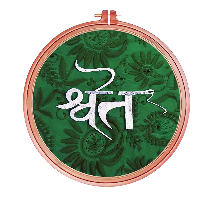The Best Time to Buy Chikankari? Between Eid and Diwali—Here’s Why
Share
Introduction
“From Roohani Eid mornings to Diwali nights glittering with diyas, India’s festivals aren't just rituals—they’re reasons to dress with meaning. And when it comes to tradition wrapped in elegance, nothing beats Chikankari.”
Welcome to the golden buying season for Indianwear—the time between Eid and Diwali, when wardrobes are refreshed, gifts are exchanged, and heritage takes the spotlight. But why is this specific window so important for Chikankari artisans, shoppers, and conscious fashion lovers alike?
Let’s unravel the story.
Why Eid Kicks Off the Chikankari Buying Season
Eid is about purity, celebration, and fresh beginnings. And Chikankari—with its delicate whitework and serene aesthetics—feels tailor-made for this festival.
The Eid Connection:
White-on-white Chikankari kurtas are a staple for both men and women during Eid-ul-Fitr.
 It represents nazakat (grace) and taharat (purity)—two deeply cultural values aligned with the festival.
It represents nazakat (grace) and taharat (purity)—two deeply cultural values aligned with the festival.
Many families buy new Chikankari outfits after Ramadan as a form of reward, celebration, and tradition.
This festival marks the beginning of bulk orders in the Lucknowi hand-embroidery industry, as designers prep collections to drop before the festival rush.
Raksha Bandhan & Teej: Gifts Wrapped in Handcrafted Love
Between Eid and Diwali, festivals like Teej, Rakhi, Janmashtami, and Karwa Chauth become the next big wave for ethnic shopping.
Why Chikankari Works So Well as a Gift:
It’s handmade, personal, and carries a story—ideal for sister-brother gifting.
Lightweight kurtas and sarees are easy to ship and fit into gift boxes.
It blends tradition with trend—especially for younger generations looking for sustainable luxury.
Shoppers start looking for pastel Chikankari kurtis, crop top–lehenga sets, and fusion dupattas around this time, especially for styling Instagram-worthy moments.

Why Diwali is Peak Season for Chikankari
If Eid is the start, Diwali is the grand finale.
Diwali is a time for sparkle. But not everyone wants sequins. More and more urban Indian shoppers are choosing understated elegance over bling—and that’s where Chikankari shines.
Diwali & the Rise of Slow Fashion:
Think soft organza kurtas with mukaish work or Chikankari sarees with subtle gota patti—a perfect blend of heritage and glamour.
Ethical gifting rises during Diwali, with many people opting for handcrafted stoles, clutches, and apparel over factory-made fast fashion.
It’s also a popular time for bridal trousseau shopping, especially for those seeking timeless elegance.
What the Data Says: A Seasonal Spike You Can’t Ignore
The sales graphs between July to November paint a clear picture:
| Month | Festival(s) | Chikankari Buying Trend |
|---|---|---|
| June–July | Eid-ul-Adha | Light kurtas, white-on-white |
| Aug | Raksha Bandhan, Teej | Pastel fusion styles, gift sets |
| Sept | Ganesh Chaturthi, Onam | Sarees, semi-formals |
| Oct–Nov | Navratri, Diwali, Karwa Chauth | Festive formalwear, bridal sets |
Google search trends for “Chikankari kurti,” “Lucknowi suits,” and “hand embroidery India” show a 30–60% spike in this window compared to other months.
Behind the Scenes: What Artisans Do During This Season
This period is also the most crucial for Chikankari artisans in Lucknow and surrounding villages. Many begin production in February–March so that the work is ready for festive deliveries by July–November.

“For us, Diwali doesn’t mean lights—it means deadlines,” laughs Nagma, a fourth-generation Chikankari artisan from Chowk Bazaar, Lucknow.
The rush of orders supports entire artisan families. Every stitch during this season becomes a celebration of heritage, survival, and art.
Why You Should Shop Chikankari During Festival Season
If you’ve been meaning to invest in Indianwear that’s:
Handcrafted, not mass produced
Celebratory, yet soft on the planet
…then this festive season is the best time to do it.
Not only do you get wider collections and limited-edition pieces, but your purchase directly contributes to sustaining an endangered heritage.
Where to Begin?
Start with:
A white-on-white Lucknowi kurta for Eid or Rakhi
A Chikankari dupatta to style over basics
A festive crop set with embroidery for Diwali parties
Or a gift box from Shwet Artistry that includes handmade stoles and artisan notes
You’ll find them all in our Chikankari Festive Edit 2025 →
Final Thoughts: Festivals With Soul
Between Eid’s prayers and Diwali’s diyas lies something bigger than outfits—it’s about expression, emotion, and handmade joy.
And Chikankari? It isn’t just thread on fabric. It’s the quiet luxury of being rooted, seen, and celebrated.
At Shwet Artistry, every Chikankari thread is hand-embroidered by artisans who carry centuries of legacy—so when you shop with us, you're not just wearing heritage, you're preserving it.
So this year, don’t just buy ethnicwear. Choose something handmade with heritage, stitched in stories.
